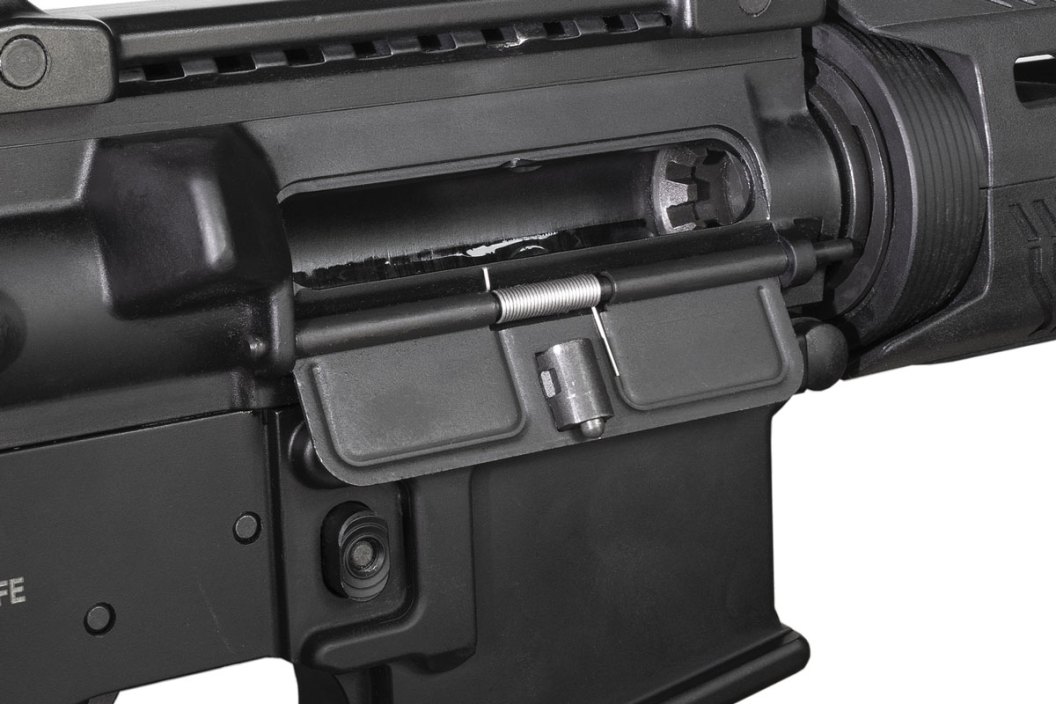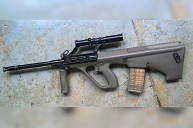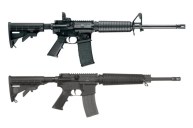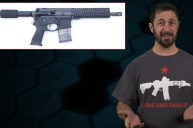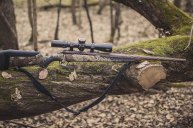The only way to build an AR-15 is to understand every part of the platform.
Typically to own and use a firearm, you don't need to know every single part intimately. If you know how to break it down to clean it, that's usually enough. In fact, some firearms come with warnings from the factory to not disassemble most components, because they require specialized tools to do so correctly.
But the modular AR-15 was built to be relatively simple and serviceable by just about anyone. If you buy a stripped lower receiver for an AR-15 and an upper receiver and you want to turn it into a working firearm, you're going to have to know every single component and how it works, because you're going to have to install each one.
The first thing you need to do is make sure you have a good list of all the AR-15 parts you need before deciding on the actual components. Because the platform is modular, the parts are pretty much the same whether you're building an AR-15 rifle, carbine or pistol.
Lower Receiver Parts
And AR-15 has a two-part receiver composed of an upper receiver and a lower receiver. The lower is the serialized component of the firearm and includes the grip, trigger mechanism, magazine well and buffer tube assembly and buttstock attack to the rear.
Here's a breakdown of all the parts of the lower and what they do. Most of these parts, aside from the buffer tube, spring and stock, can be purchased together as a lower parts kit. These will sometimes include a trigger and/or a pistol grip.
Lower Receiver Body - The bottom half of an AR-15 receiver, typically machined from a solid billet of aluminum.
Magazine Catch and Release Button - This is a two part spring-loaded assembly that locks the magazine in place in the magwell and releases it when the button is pushed.
Bolt Catch - This mechanism locks the bolt in the rearward position and releases it into battery. It is composed of the catch, a plunger and spring, and a roll pin secures it to the receiver.
Trigger - A mil-spec AR-15 trigger assembly is composed of five parts: a disconnector, a disconnector spring, the actual trigger, a trigger spring and a trigger pin. The other half of the trigger is the hammer assembly, which includes a hammer, a J-spring, a hammer spring and a hammer pin.
With a drop-in trigger, all these components come housed in a single module that is secured in the lower receiver with two pins.
Captive Pivot Pin - This is the large pin that secures the lower receiver to the upper receiver at the front. It includes the pin itself, a spring, and a detent that captures the pin so it cannot fall out of the receiver.
Captive Takedown Pin - Secures the upper to the lower at the rear and is the only pin that must be tapped out to break down the firearm for cleaning. Like the pivot pit, the takedown pin assembly includes the pin itself, a spring and a detent.
Buffer Retainer and Spring - This holds the buffer spring in place when the receiver halves are separated.
Buffer Tube and Buttstock - The buffer tube is an aluminum tube that screws into the rear of the receiver and houses the buffer spring assembly. The buttstock also attaches to the buffer tube.
The buffer tube for an adjustable six-position type stock will be key shaped, and after being threaded into the receiver, it is locked down by a castle nut, which also holds an endplate in place.
When installed, the buffer tube holds the buffer retainer in place, and the endplate holds the takedown pin spring in place. The adjustable buttstock is then attached to the buffer tube, with holes on the bottom of the tube indexing its position.
The buffer tube for a fixed A1 or A2 style stock, will be cylindrical with a threaded hole at the back for a bolt. When the tube is threaded into the receiver, it holds the buffer retainer in place. The buttstock then slides over the buffer tube and a bolt holds it in place at the rear. This type of stock doesn't require an endplate or castle nut, and the front face of the stock itself holds the takedown pin spring in place.
Buffer Spring and Buffer - This large spring, housed in the buffer tube, pushes the bolt carrier group forward as the gun cycles. Once the spring is inserted into the buffer tube, the buffer itself is inserted inside the front of the spring. The buffer is the part that actually interacts with the bolt carrier group. The entire assembly is held in place by the buffer retainer..
Safety Selector Switch - This lever acts as a manual safety on a semi-automatic AR-15, and as a fire selector and safety on a military AR. The assembly includes the switch itself and a spring, and a detent to hold it in place. An ambidextrous assembly will be slightly different.
Pistol Grip - The grip of the firearm. It attaches to the receiver via a bolt and washer, and it also holds the safety selector switch spring in place and under tension when installed.
Trigger Guard - This small piece completes the shape of the trigger guard that is mostly created by the receiver itself. It is pinned in place by two pins and spans the gap beneath the trigger. Some trigger guards are part of the pistol grip assembly.
Magazine - A spring loaded box that holds ammo for the firearm and feeds it into the action. A magazine can be made of polymer, like Magpul PMags, or metal and includes the magazine body, spring, follower and baseplate.
Upper Receiver Parts
An AR-15 upper receiver is the top half of the firearm. It houses the bolt carrier group and attaches to the barrel. A1 and A2 style uppers will include a carry handle on the top, which houses the rear iron sight. Most uppers are topped with a section of Picatinny rail for optics.
Forward Assist - This is a plunger mechanism that engages teeth on the BCG so it can force the bolt into battery if it should get hung up for any reason. The assembly includes a the forward assist plunger, a large spring, pin, a pawl, pawl spring and pawl detent. Not all AR-15 uppers includes a port for a forward assist.
Ejection Port Cover - A simple aluminum place that covers the ejection port of the gun when not in use. It is held in place by a long pin and a retaining ring and it is held open by a spring.
Barrel - An AR-15 barrel threads into a barrel extension, which is then inserted into the front of the upper receiver. A notch in the threads matches with a nub on the barrel extension to index the barrel correctly.
Barrel Nut - The barrel nuts tightly locks the barrel onto the receiver.
The type of barrel nut you use depends on the type of handguard you have.
For an old-school two-piece military style handguard, the barrel nut will not only lock the barrel into the receiver, but it also holds a delta ring, weld spring, and snap ring in place. These types of barrel nuts will usually require a special barrel nut wrench (and a torque wrench) to tighten them down properly.
For a free-float handguard, a proprietary barrel nut will usually be included that will allow the handguard to be easily mounted to it—different companies use different mounting methods. These barrel nuts can usually be installed with an open end or adjustable wrench of the proper size.
Gas Tube - This is the heart of the AR's simple gas system. The gas tube siphons gas from a fired cartridge from the barrel and channels into the action to send the bolt rearward, cycling the action. Gas tubes come in three standard lengths, carbine length, mid-length, and rifle length. Smaller tubes will be used for AR pistols.
Gas Block and Pin or Front Sight Base and Pins - The rear of the gas tube is inserted into a hole in the upper receiver above the barrel nut. The front is inserted into a gas block positioned in the proper location on the barrel and pinned in place.
If an AR uses a two-part handguard, it will usually have an A2 style front site base as well. This part functions as the firearm's front iron sight and as the gas block. It is pinned onto the barrel with two sight base pins along with a handguard cap that will capture the front edges of a two-part handguard. The gas tube is then pinned to the front sight base.
Muzzle Device - The muzzle of an AR barrel is threaded to accept a simple flash hider or compensator or anything from a complex muzzle brake to a QD mount for a suppressor, or a suppressor itself.
Handguard - A handguard covers the barrel, the gas tube, and the gas block if using one and provides a place for the support hand to hold the firearm.
As previously mention, if a rifle has a delta ring and a front sight assembly, it will take a two piece handguard. Place the buttstock on the floor and pull down on the delta ring. The front of the two halves of the handguard can then be inserted into the handguard cap. Releasing the delta ring will lock the assembly in place.
A free-float handguard will attach to the barrel nut, usually with a series of small bolts. A narrow or low profile handguard will require the use of a low profile gas block. These types of handguard will include rails sections or M-Lok slots for attaching accessories.
Magpul also makes a two-part handguard with M-Lok slots for easily attaching accessories when not using a free-float barrel.
Charging Handle - This part allows the user to manually charge the rifle by pulling the BCG to the rear against the tension of the buffer spring. The assembly includes the handle, a latch, and a spring and pin to hold the latch in place.
Bolt Carrier Group (BCG) - This is the reciprocating part of the rifle that houses the firing pin, the ejector, and extractor. It is inserted into the upper receiver at the rear along with the charging handle.
NEXT: THE BEST 5 POCKET-CARRY HANDGUNS ON THE MARKET TODAY
WATCH
